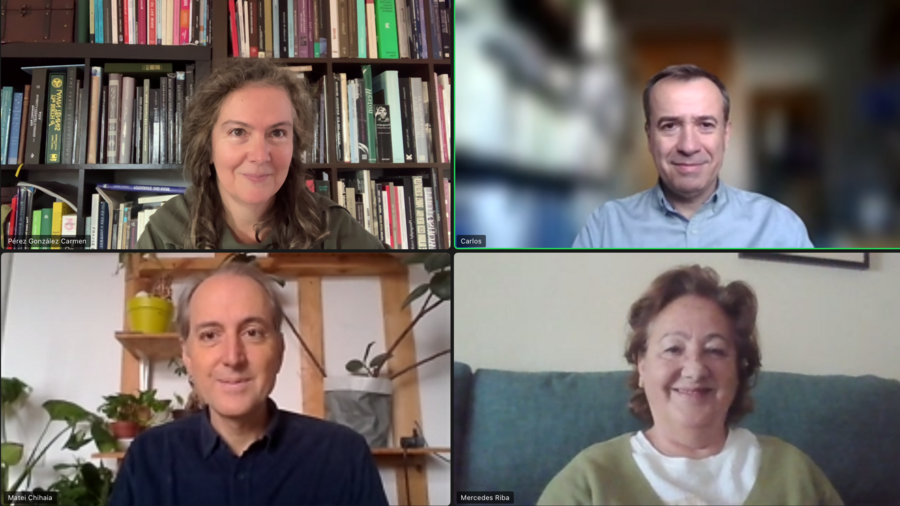
Dr Carmen Pérez González/ History of Science and Technology, Prof Carlos Sanz Díaz/ Universidad Complutense de Madrid
Prof. Dr Matei Chihaia / Romance Studies, Mercedes Riba Hernández / Writer
Screenshot: González
Spanish textile workers in the Bergisches Land
Carmen Pérez González and Matei Chihaia on the project "Thread of Remembrance" on the welcoming culture for Spanish guest workers at the textile factories of Johann Wülfing & Sohn
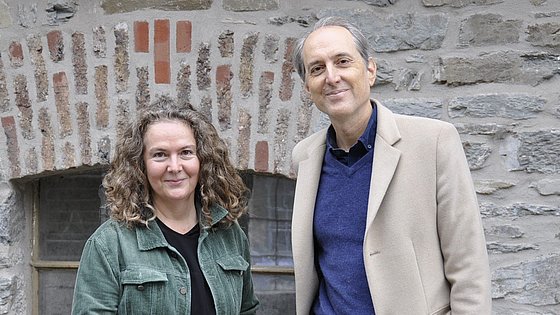
Carmen Pérez González and Matei Chiaia in front of the Wülfing Museum
Photo: UniService Third Mission
The history of Spanish guest workers in the Bergisches Land region began on 19 March 1960 with 41 women from Béjar in Spain and two from Salamanca, who arrived in Remscheid-Lennep by coach after almost three days and 2000 kilometres, accompanied by Horst Kubiak, Head of Human Resources at Johann Wülfing & Sohn. Carmen Pérez González from the History of Science and Technology and Matei Chihaia from Romance Studies, both academics at the University of Wuppertal, have researched the history of the Spanish women workers in various archives together with colleagues from Spain and are preparing a travelling exhibition that aims to trace the long journey of these women from the province of Salamanca to the Bergisches Land.
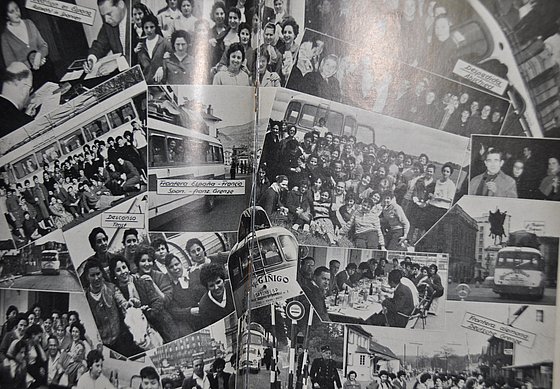
Photo collage about the journey of the guest workers Photo: Wülfing company newspaper
Spanish immigrants in North Rhine-Westphalia
Photo historian Carmen Pérez González has been working with historical photographs and their potential use in reminiscence therapy for senior citizens with Alzheimer's for a good five years. "This topic led me to another topic, namely 'Alzheimer's and migration'," she says, "and I realised that these immigrants often have a harder time than natives because the first thing they do when they develop Alzheimer's is to unlearn the language they last acquired. And there are really very few culturally sensitive non-pharmacological therapy programmes (a worldwide problem)." She researched Spanish immigrants in North Rhine-Westphalia and came across two interesting works. "I found articles by Carlos Sanz Díaz, professor of contemporary history at the Universidad Complutense de Madrid, who has published numerous studies on Spanish labourers in Germany during the Franco regime, examining their forms of mobility and their role in the regime's migration and foreign policy. And I found a great book by the Spanish writer Mercedes Riba Hernández: La emigración bejarana en Alemania. 1960-1973. Aproximación sociológica (2023) (Emigration from Béjar to Germany. 1960-1973. A sociological approach (2023).
This book is about the Spanish guest workers who came to North Rhine-Westphalia, specifically to Remscheid and Lennep, to work in the textile industry. I was also interested in this because I myself come from the area where these women came from, namely Béjar." Pérez González and Chihaia have known each other for many years and always exchange information about their research. They realised that the Romanist had also already worked on this topic. "I was invited to a conference in Madrid about travelling and heard a presentation by Carlos Sanz Díaz on a graphic novel about Wuppertal and the Bergisches Land region," he reports. "Then I also read this graphic novel, 'Snow in the Pockets' (2018), and was thrilled because I learnt about an aspect of the Bergisches Land that I hadn't noticed at all: the topic of guest workers from Spain. I then invited KIM, the author of 'Snowin the Pockets', to Wuppertal and organised an exhibition about it. And for the preparation of this exhibition, I particularly worked out the different voices of female guest workers that appear in the graphic novel. And among them were these women from Béjar, whom KIM had met in the 1960s and who play an important role in his book." This is how the photo historian and the novelist came together.
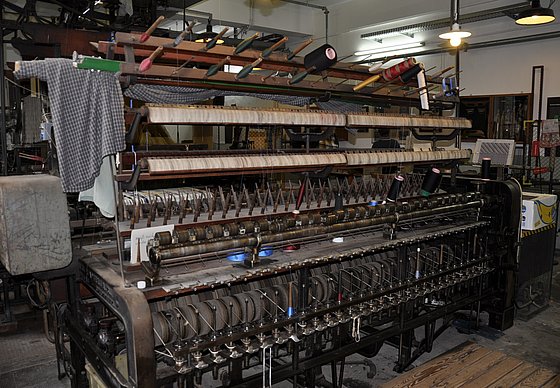
Textile machine in the Wülfing Museum
Photo: UniService Third Mission
Raising awareness of memories
"In Spain, the topic of migrant women workers is remembered a lot, there are important works in cultural centres in Madrid and also in Béjar," explains Chihaia, "but here in the Bergisches Land it is not so well known." There is a specific reason why the women came to this region. "They weren't normal workers, but skilled workers from the textile industry," says Pérez González, "Béjar was and still is one of the main centres of the textile industry in Spain. They all got a contract here, but not only did they work here, they also trained guest workers from other countries. So they were happy to be employed." There is a structural similarity between the Salamanca region and the Bergisches Land, even though the landscapes are so different.

Wülfing company newspaper
Photo: UniService Third Mission
Works magazine "Spindle and shooters"
In the period between 1960 and 1973, these Spanish women - more than 700 people, according to 15 coach trips - brought with them not only their labour, but also their language, their cultural practices and their forms of sociability. They became, so to speak, living carriers of Spanish culture in one of Europe's industrial centres. And this can be wonderfully traced in Wülfing's own company newspaper in Dahlerau. Chihaia comments: "In the magazine 'Spindel und Schützen', this is very well documented photographically, because there is an emphasis on the leisure activities of the Spanish women. You can see them watching television or listening to Spanish radio. There are also request concerts with music sent to them from home. You see them knitting and writing. Many letters are exchanged, but also tape recordings, and the Spanish language is very present in the Wülfing factory, also because the factory magazine was partly published in Spanish. The region plays an important role." The factory magazine was published monthly and reported on new employees, marriages, children, long-term illnesses, religious moments and excursions, among other things. "They documented everything for the guest workers. The factory magazines were heavily illustrated, there were interpreters who were always available if there were problems at the factory and they also took care of the women's well-being."

Magdalena Iglesias Esteban in the magazine Scala international 1961
Photo: Archive Museum Wülfing
Contemporary witnesses condense the thread of memory
There are both academic works and documentary films on this topic. Chihaia explains that there is also the valuable tradition from grandmothers to daughters and granddaughters, some of whom still live here, and says: "We also want to engage with these stories. So we are not only interested in the stories about labour migration that are formulated in these magazines, but also in the stories of the migrant women themselves. Carmen Pérez González has made contact with many people who once worked here, i.e. contemporary witnesses." She also found graves of former guest workers at the Lennep Forest Cemetery, the researcher explains, and met a great-niece living here who had discovered her great-aunt Magdalena Iglesias Esteban on the cover of one of the magazines about guest worker culture at the time. The Federal Association of Spanish Social and Cultural Organisations in Remscheid, where many descendants are active, is an important cooperation partner for the project.
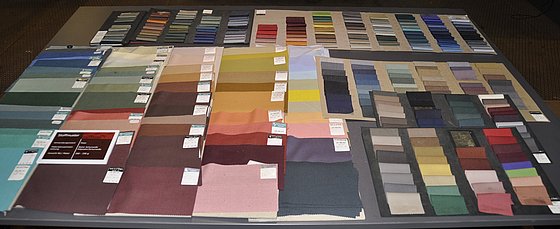
Fabric samples in the Wülfing Museum
Photo: UniService Third Mission
Exhibition, animated film and international conference
The two initiators of the 'Thread of Memory' project, Pérez González and Chihaia, want to devote themselves to the topic with new elements by next autumn. "An exhibition is planned, of course," says the photo historian, "but not just a photo exhibition. We also want to use other materials, such as these magazines and textiles, in other words the material that women used on a daily basis." The entire exhibition will be realised by students from the University of Wuppertal. To this end, Pérez González is offering a seminar for Master's students who speak Spanish at a high level. This exhibition will then be presented at the Johannes Rau Centre on the Freudenberg campus in Wuppertal. "But of course we would like to show this exhibition in the region, it could even become a permanent exhibition," she says and continues enthusiastically, "and then we plan to take this exhibition to Madrid and finally to Béjar. It will be a travelling exhibition, but unlike the workers, this time it will travel in the opposite direction, from North Rhine-Westphalia to Spain." In addition, an animated film is to be created, for which a renowned artist has been recruited: Cologne-based Alireza Darvish, whose contribution to the documentary film 'Fritz Litzmann, my father and I' is currently in cinemas. "The idea is that this first historic journey in 1960 with 41 guest workers, this odyssey, is realised on film." The photos serve as milestones, so to speak. They show them leaving home, crossing the border into France, life on the bus and arriving in the Bergisches Land. "But what you can't see there, because there are no films of this journey, will be completed in intermediate steps with drawings," she explains. "This will then be the centrepiece of the exhibition," adds Chihaia, "it's important to us that we use drawings to make it clear that this is a reconstruction of memory, especially in the wake of AI, where everything can be generated." A symposium at the German Tool Museum in Remscheid, attended by historians and artists from Germany and Spain, will round off the project in October 2026. Chihaia comments: "The Historical Centre in Remscheid is a museum where the international network of the Bergisches Land and the innovative potential of the region are more evident than anywhere else, and we want to exploit and strengthen this."
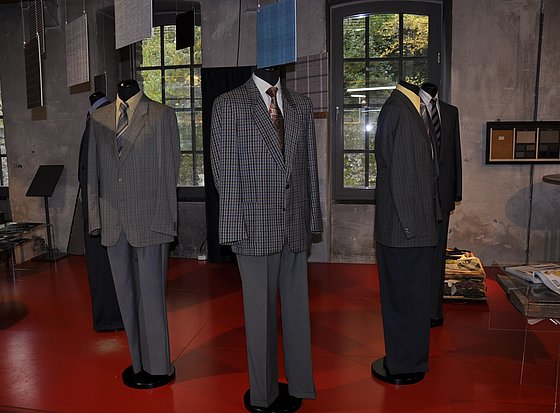
Suits in the museum exhibition
Photo: UniService Third Mission
Interesting fragments of Spanish culture remain to this day
When asked what remains of the Spanish workers in the Bergisches Land region today, the Romance scholar spontaneously replies: "The granddaughters are studying Spanish with us." The exhibition will show many photos and even today you can still visit the traditional restaurant 'Meson Alegria' in Wuppertal Elberfeld, for example, which dates back to this generation. "And the Catholic Sunday mass in Lennep is still held in Spanish," adds Pérez González.
The entire project is funded by the Spanish Ministry of Culture through the Hispanex programme and by the Friends and Alumni of the University of Wuppertal. Further sponsors are welcome.
Uwe Blass
Dr Carmen Pérez González is an astrophysicist, photo historian and lecturer in history at the School of Humanities and Cultural Studies at the University of Wuppertal. She is the founder of the "Golden Memories" project.
Prof Dr Matei Chihaia studied Comparative Literature, Romance Studies and Philosophy at the Ludwig-Maximilians-Universität in Munich and at the University of Oxford. He has been teaching French and Spanish literature at the University of Wuppertal since 2010.
